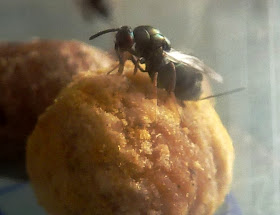I've written quite a few posts about bees, especially garden species (search for 'bees' on this blog and you'll see!), but having found around 20-25 species so far, there is plenty more to look at. For instance, yesterday I noted a small-to-medium stripy bee being chased away by a leaf-cutter. Naturally, I grabbed my camera and watched what was happening. The smaller bee turned out to be quite an interesting species...
 |
| Male Coelioxys rufescens |
I was interested to see a species of
Coelioxys in the garden as none of them are especially common in Britain. They can be difficult to identify, although there are only seven species in this country and two are coastal, so the options are limited. This one is a male - the abdomen is blunt with short spines whereas the female has an elongtae pointed abdomen. Also, the species are all cuckoo bees ('cleptoparasites') which means they take over cells in the nests of their host bees, all of which are in the genera
Megachile and
Anthophora. They do this by the female using her elongated abdomen to cut into the host cell and lay an egg through the hole. Young
Coelioxys larvae have long, curved jaws which they use to destroy the host egg or larva; they then feed on the food stores of the host, with later instars (larval stages) having normal jaws.
C. rufescens is fairly widespread in south and SE England (scattered further north), though
Coelioxys species may be under-recorded; I have recorded it in our garden in previous years, as well as one of its possible hosts, the leaf-cutter bee
Megachile centuncularis - there are several others noted in Collins & Roy (2012) though the full host range is uncertain. It flies fairly early (from June) for a British
Coelioxys (along with
C. elongata); most are not active until July.
 |
| Megachile centuncularis approaching a common bird's-foot trefoil (Lotus corniculatus) |
 |
| Megachile centuncularis feeding on a garden thistle (Cirsium sp.) |
If
M. centuncularis is a host of
C. rufescens, this might explain the aggressive behaviour seen, with the parasitic species being repeatedly chased away (though not a nest/host-searching female). Host-parasite interactions can be fascinating and tell us much about evolutionary processes - for example, some cleptoparasites may mimic chemical cues to avoid anti-parasite strategies (e.g. Strohm
et al., 2008), and it seems reasonable to suggest that hosts can detect their parasites. This of course does not confirm that
M. centuncularis is a host species, but it a good indication that it is something worth investigating more closely...
Reference
Collins, G.A. & Roy, H.E. (eds.) (2012).
Provisional Atlas of the Aculeate Hymenoptera of Britain and Ireland. Part 8. BRC, Wallingford.
Strohm, E., Kroiss, J., Herzner, G., Laurien-Kehnen, C., Boland, W., Schreier, P. & Schmitt, T. (2008). A cuckoo in wolves' clothing? Chemical mimicry in a specialized cuckoo
wasp of the European beewolf (Hymenoptera, Chrysididae and Crabronidae).
Frontiers in Zoology 5(2). [
online] [accessed 06/06/2013].

















